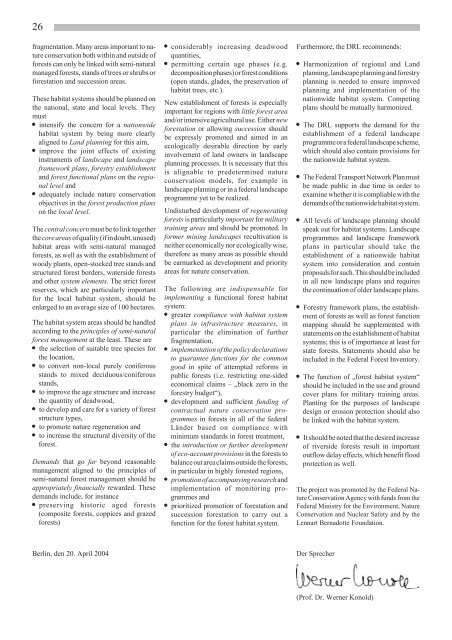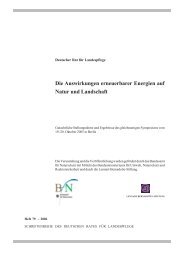Der Beitrag der Waldwirtschaft zum Aufbau eines - Deutscher Rat für ...
Der Beitrag der Waldwirtschaft zum Aufbau eines - Deutscher Rat für ...
Der Beitrag der Waldwirtschaft zum Aufbau eines - Deutscher Rat für ...
Erfolgreiche ePaper selbst erstellen
Machen Sie aus Ihren PDF Publikationen ein blätterbares Flipbook mit unserer einzigartigen Google optimierten e-Paper Software.
26<br />
fragmentation. Many areas important to nature<br />
conservation both within and outside of<br />
forests can only be linked with semi-natural<br />
managed forests, stands of trees or shrubs or<br />
forestation and succession areas.<br />
These habitat systems should be planned on<br />
the national, state and local levels. They<br />
must<br />
intensify the concern for a nationwide<br />
habitat system by being more clearly<br />
aligned to Land planning for this aim,<br />
improve the joint effects of existing<br />
instruments of landscape and landscape<br />
framework plans, forestry establishment<br />
and forest functional plans on the regional<br />
level and<br />
adequately include nature conservation<br />
objectives in the forest production plans<br />
on the local level.<br />
The central concern must be to link together<br />
the core areas of quality (if in doubt, unused)<br />
habitat areas with semi-natural managed<br />
forests, as well as with the establishment of<br />
woody plants, open-stocked tree stands and<br />
structured forest bor<strong>der</strong>s, waterside forests<br />
and other system elements. The strict forest<br />
reserves, which are particularly important<br />
for the local habitat system, should be<br />
enlarged to an average size of 100 hectares.<br />
The habitat system areas should be handled<br />
according to the principles of semi-natural<br />
forest management at the least. These are<br />
the selection of suitable tree species for<br />
the location,<br />
to convert non-local purely coniferous<br />
stands to mixed deciduous/coniferous<br />
stands,<br />
to improve the age structure and increase<br />
the quantity of deadwood,<br />
to develop and care for a variety of forest<br />
structure types,<br />
to promote nature regeneration and<br />
to increase the structural diversity of the<br />
forest.<br />
Demands that go far beyond reasonable<br />
management aligned to the principles of<br />
semi-natural forest management should be<br />
appropriately financially rewarded. These<br />
demands include, for instance<br />
preserving historic aged forests<br />
(composite forests, coppices and grazed<br />
forests)<br />
consi<strong>der</strong>ably increasing deadwood<br />
quantities,<br />
permitting certain age phases (e.g.<br />
decomposition phases) or forest conditions<br />
(open stands, glades, the preservation of<br />
habitat trees, etc.).<br />
New establishment of forests is especially<br />
important for regions with little forest area<br />
and/or intensive agricultural use. Either new<br />
forestation or allowing succession should<br />
be expressly promoted and aimed in an<br />
ecologically desirable direction by early<br />
involvement of land owners in landscape<br />
planning processes. It is necessary that this<br />
is alignable to predetermined nature<br />
conservation models, for example in<br />
landscape planning or in a fe<strong>der</strong>al landscape<br />
programme yet to be realized.<br />
Undisturbed development of regenerating<br />
forests is particularly important for military<br />
training areas and should be promoted. In<br />
former mining landscapes recultivation is<br />
neither economically nor ecologically wise,<br />
therefore as many areas as possible should<br />
be earmarked as development and priority<br />
areas for nature conservation.<br />
The following are indispensable for<br />
implementing a functional forest habitat<br />
system:<br />
greater compliance with habitat system<br />
plans in infrastructure measures, in<br />
particular the elimination of further<br />
fragmentation,<br />
implementation of the policy declarations<br />
to guarantee functions for the common<br />
good in spite of attempted reforms in<br />
public forests (i.e. restricting one-sided<br />
economical claims – „black zero in the<br />
forestry budget“),<br />
development and sufficient funding of<br />
contractual nature conservation programmes<br />
in forests in all of the fe<strong>der</strong>al<br />
Län<strong>der</strong> based on compliance with<br />
minimum standards in forest treatment,<br />
the introduction or further development<br />
of eco-account provisions in the forests to<br />
balance out area claims outside the forests,<br />
in particular in highly forested regions,<br />
promotion of accompanying research and<br />
implementation of monitoring programmes<br />
and<br />
prioritized promotion of forestation and<br />
succession forestation to carry out a<br />
function for the forest habitat system.<br />
Berlin, den 20. April 2004 <strong>Der</strong> Sprecher<br />
Furthermore, the DRL recommends:<br />
Harmonization of regional and Land<br />
planning, landscape planning and forestry<br />
planning is needed to ensure improved<br />
planning and implementation of the<br />
nationwide habitat system. Competing<br />
plans should be mutually harmonized.<br />
The DRL supports the demand for the<br />
establishment of a fe<strong>der</strong>al landscape<br />
programme or a fe<strong>der</strong>al landscape scheme,<br />
which should also contain provisions for<br />
the nationwide habitat system.<br />
The Fe<strong>der</strong>al Transport Network Plan must<br />
be made public in due time in or<strong>der</strong> to<br />
examine whether it is compliable with the<br />
demands of the nationwide habitat system.<br />
All levels of landscape planning should<br />
speak out for habitat systems. Landscape<br />
programmes and landscape framework<br />
plans in particular should take the<br />
establishment of a nationwide habitat<br />
system into consi<strong>der</strong>ation and contain<br />
proposals for such. This should be included<br />
in all new landscape plans and requires<br />
the continuation of ol<strong>der</strong> landscape plans.<br />
Forestry framework plans, the establishment<br />
of forests as well as forest function<br />
mapping should be supplemented with<br />
statements on the establishment of habitat<br />
systems; this is of importance at least for<br />
state forests. Statements should also be<br />
included in the Fe<strong>der</strong>al Forest Inventory.<br />
The function of „forest habitat system“<br />
should be included in the use and ground<br />
cover plans for military training areas.<br />
Planting for the purposes of landscape<br />
design or erosion protection should also<br />
be linked with the habitat system.<br />
It should be noted that the desired increase<br />
of riverside forests result in important<br />
outflow delay effects, which benefit flood<br />
protection as well.<br />
The project was promoted by the Fe<strong>der</strong>al Nature<br />
Conservation Agency with funds from the<br />
Fe<strong>der</strong>al Ministry for the Environment, Nature<br />
Conservation and Nuclear Safety and by the<br />
Lennart Bernadotte Foundation.<br />
(Prof. Dr. Werner Konold)




